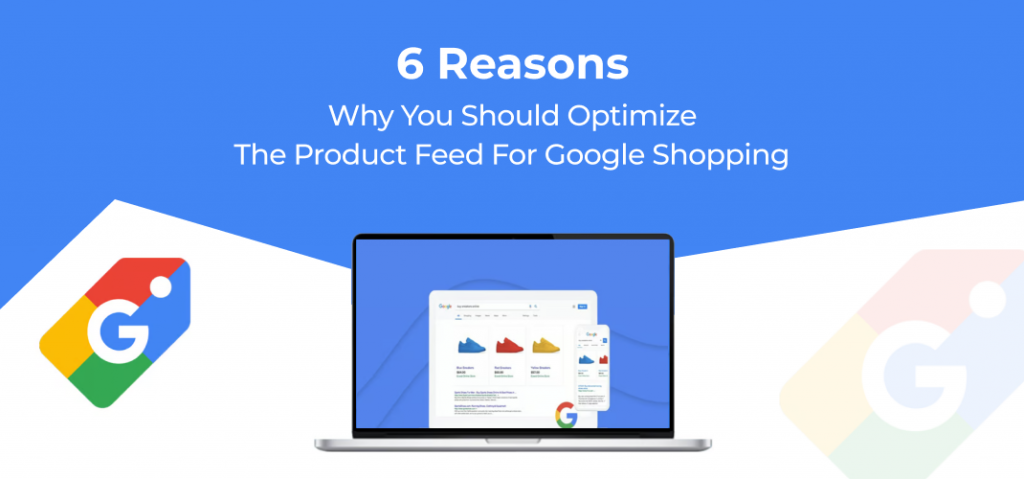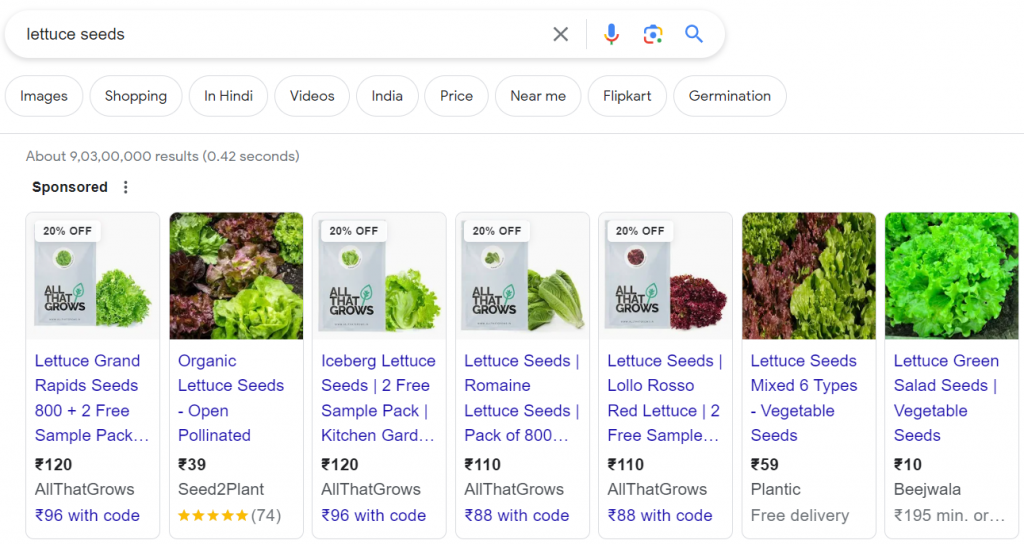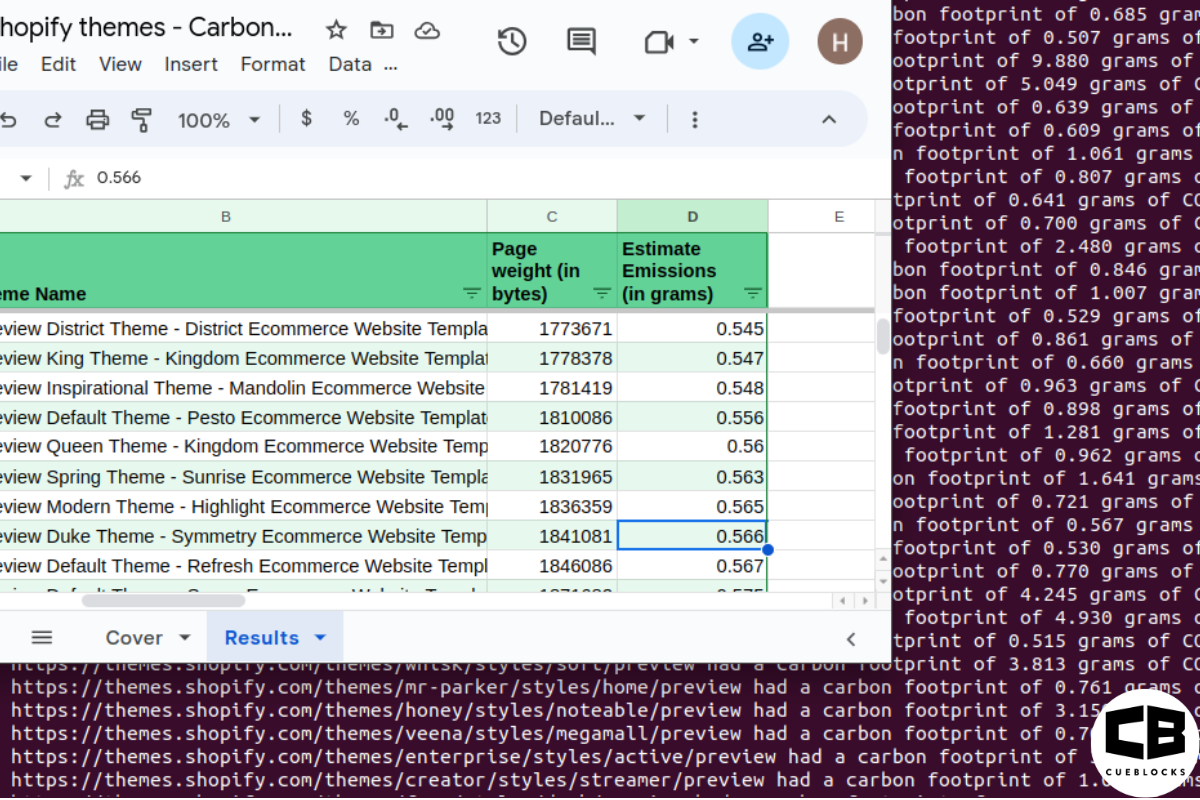
6 Reasons Why You Should Optimize The Product Feed For Google Shopping

What is a Product Feed?
A product feed, also known as a data feed or an inventory feed, is a file or data stream that contains detailed information about the products available for sale in an online store. It usually includes product attributes such as
- Title
- Description
- Price
- Availability
- Images
- Categories
- And other relevant data
Product feeds are used by online stores, comparison shopping engines, and other advertising platforms to display accurate and up-to-date product information to potential customers. By providing a standard structure for product data, product feeds enable the automated and effective sharing of product information across several online platforms.
Why is it Important to Optimize Your Product Feed for Google Shopping?
Research shows that 94% of customers will stop shopping or redirect their search to another site if they can’t find the product content they need. This is where product feed comes in. An effective product feed should contain complete and accurate data, including product attributes, pricing, and availability, along with high-quality images.
Google dominates the rank chart by remaining at the top with a massive 71% of the global search engine market share. With Google Shopping, you have the ability to show up for product-related searches at the top of search results. This means maximum visibility.

However, to generate success, listing your products alone on Google Shopping is insufficient. For your product feed to be seen by as many people as possible, get more clicks, and boost conversions, it must be optimized for Google Shopping. Since Google Shopping doesn’t rely on keywords as much as search ad campaigns, optimizing the titles and descriptions becomes crucial. By crafting compelling and informative content, we can capture shoppers’ attention, convey the unique selling points of the products, and entice them to make a purchase.
Here are six compelling reasons why you should optimize the product feed for Google Shopping:
1. Increased Visibility
An optimized feed allows Google to match products with relevant search queries.
By providing accurate and detailed data about the products, we increase the chances of our products appearing in relevant searches, ultimately improving visibility and driving more traffic to the products.
Remember that the objective is to make your product feed stand out in a crowded market by matching it with popular search terms. Your chances of having your products show up prominently when users search for pertinent keywords or phrases are increased by matching your product titles, descriptions, and attributes with popular search terms. This increased visibility can also draw more potential customers to your products.
2. Enhanced Ad Relevance
Users are more likely to click on your ads and make a purchase when they are relevant to their search intentions. Your Google Shopping ads will be highly relevant to users’ search terms if your product feed is optimized.
A well-optimized feed ensures that our products are categorized correctly, making it easier for potential customers to find what they are looking for. By organizing the products into appropriate categories and providing accurate attributes, we enhance the relevance of our listings and increase the likelihood of attracting interested shoppers.
You can stay relevant and one step ahead of the competition by continually monitoring and improving your feed depending on user behavior, market trends, and rivals’ tactics. This positions your products for long-term visibility, interaction, and conversions.
3. Better Click-Through Rates (CTR) and Conversion Rates
Users are drawn in and persuaded to learn more about your products by attractive images, precise descriptions, and clear and compelling product titles. This is further supplemented by transparent pricing, product availability, and other linked attributes.
*Salsify has reported that shoppers want to see an average of three images of the product while shopping online.
Optimizing your product feed will increase the likelihood that clicks will result in actual purchases. A seamless and trustworthy shopping experience increases the likelihood of conversions.
A higher CTR shows that your ads are connecting with your target audience and increasing website traffic.
4. Cost Efficiency
As your listing is more relevant to the user’s search intent, you are reaching users who are more likely to convert; this targeted approach reduces wasted ad spending on irrelevant clicks.
You can increase the return on investment (ROI) of your campaigns by concentrating your advertising budget on the appropriate demographic.
This increased click-through rate can also have a positive impact on your cost per click (CPC).
**The Google algorithm rewards you with a higher ad quality score when your ads are more relevant and engaging, which can result in lower CPCs. This means you can improve ad placement and visibility while spending less per click.
5. Adaptability and Scalability
Optimizing your product feed allows your Google Shopping campaigns to be more adaptable and scalable.
By continuously monitoring your feed, you can readily update and optimize it as your product offerings change or new products are introduced.
If you run offers or have discounts, updating the feed will make sure that your ads show the most recent and accurate rates. As soon as you add new items to your inventory, make sure to swiftly update the feed so that they appear in your Google Shopping advertising. This transparency fosters customer trust and lessens the possibility of price differences between your website and your ads.
This adaptability ensures that your ads always display the most accurate and up-to-date information, providing potential customers with a seamless shopping experience.
Furthermore, as your business grows, optimizing the product feed allows you to efficiently scale your campaigns, reaching a larger audience and driving more sales.
6. Meet the Guidelines
Google’s aim is to provide users with useful and accurate information in the search results. Including promotional text or excessive punctuation in your titles can make them appear spammy and detract from the overall user experience. It’s best to keep your titles concise, descriptive, and free from any promotional language.
Your Google Shopping advertising will perform better overall if you adhere to the recommendations. Your product feed’s significance, quality, and visibility are all improved when it complies with the standards. This can therefore result in better conversion rates, click-through rates (CTR), and return on ad spend (ROAS).
Conclusion
Decisions concerning purchases are significantly influenced by optimizing the product feed for running Google Shopping campaigns. Enhancing the visual impact, offering thorough product information, enabling comparison shopping, highlighting positive reviews and ratings, adapting to mobile shoppers, increasing search relevance, and establishing credibility are just a few of its many benefits.
The likelihood of conversions and sales can be increased by utilizing these factors to convince potential customers.
You can position your brand for success in the competitive e-commerce landscape by putting time and effort into optimizing your product feed. It is a valuable strategy for increasing traffic, attracting qualified leads, and increasing sales via Google Shopping.
Remember that optimizing the Google Shopping feed is an ongoing process. Continuously monitor the performance of the campaigns, analyze data, and make adjustments based on insights and trends to stay competitive and achieve the best results.
To gather more information on the tips and tricks of the e-commerce world, keep reading CueBlog!
Need assistance with Google Shopping? We are here to help. Drop us a mail at – letstalk@cueblocks.com
- About the Author
- Latest Posts
Working with CueBlocks as the Division Head of Digital Marketing (CSE), I specialize in managing Comparison Shopping Engines (CSEs) and Marketplaces, with a particular emphasis on optimizing Google Shopping Ads, Amazon, and eBay platforms. My focus is on maximizing visibility and performance through effective product feed management.
-
Evaluating the Carbon Emissions of Shopify Themes
by Harleen Sandhu
Committing to green claims as a business is a huge promise to deliver on. For ecommerce stores, Shopify is leading …
Continue reading “Evaluating the Carbon Emissions of Shopify Themes”
-
Dark Mode: Accessibility vs Sustainable Web Design
by BalbirIntroduction Dark mode, a feature that lets users switch the color scheme of an app or website to darker colors, …
Continue reading “Dark Mode: Accessibility vs Sustainable Web Design”
-
Discover Essential Sustainable Marketing Principles and Strategies for Ethical Business Growth
by Pancham Prashar
Given the major issues that our world is currently facing, such as pollution and climate change, sustainability becomes an inevitable …
-
Show, Don’t Tell: Demonstrating Transparency in Your eCommerce Store
by Pancham PrasharFor an eCommerce brand committed to good, success goes beyond creating excellent products; it extends to effectively communicating your values …
Continue reading “Show, Don’t Tell: Demonstrating Transparency in Your eCommerce Store”
-
How to Market Sustainable Products Effectively
by Nida Danish
In today’s market, sustainability has evolved from a passing trend to a pivotal consideration for both consumers and businesses. Globally, …
Continue reading “How to Market Sustainable Products Effectively”
-
Decoding B Corp Marketing Challenges: Strategies for Success
by Nida DanishToday, businesses place high importance on sustainability and ethical practices. For B2B and e-commerce leaders, being a certified B Corp. …
Continue reading “Decoding B Corp Marketing Challenges: Strategies for Success”




